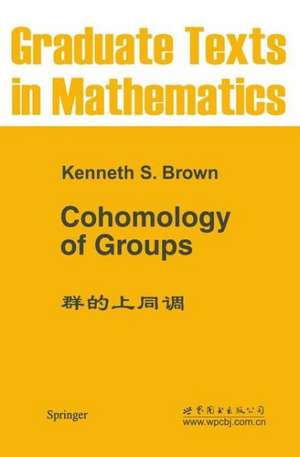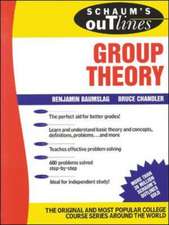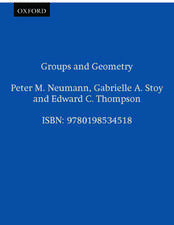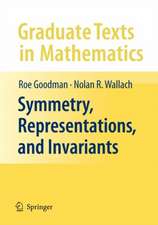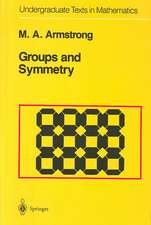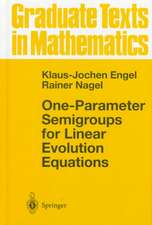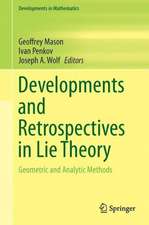Cohomology of Groups: Graduate Texts in Mathematics, cartea 87
Autor Kenneth S. Brownen Limba Engleză Hardback – oct 1982
| Toate formatele și edițiile | Preț | Express |
|---|---|---|
| Paperback (1) | 403.55 lei 38-44 zile | |
| Springer – 28 apr 2012 | 403.55 lei 38-44 zile | |
| Hardback (1) | 535.15 lei 6-8 săpt. | |
| Springer – oct 1982 | 535.15 lei 6-8 săpt. |
Din seria Graduate Texts in Mathematics
- 17%
 Preț: 528.66 lei
Preț: 528.66 lei -
 Preț: 337.45 lei
Preț: 337.45 lei -
 Preț: 383.85 lei
Preț: 383.85 lei -
 Preț: 402.87 lei
Preț: 402.87 lei - 17%
 Preț: 398.97 lei
Preț: 398.97 lei -
 Preț: 355.82 lei
Preț: 355.82 lei -
 Preț: 411.83 lei
Preț: 411.83 lei -
 Preț: 404.47 lei
Preț: 404.47 lei -
 Preț: 289.88 lei
Preț: 289.88 lei - 17%
 Preț: 365.79 lei
Preț: 365.79 lei - 17%
 Preț: 359.45 lei
Preț: 359.45 lei -
 Preț: 450.64 lei
Preț: 450.64 lei - 15%
 Preț: 488.70 lei
Preț: 488.70 lei - 17%
 Preț: 430.49 lei
Preț: 430.49 lei -
 Preț: 426.27 lei
Preț: 426.27 lei - 13%
 Preț: 357.75 lei
Preț: 357.75 lei -
 Preț: 407.88 lei
Preț: 407.88 lei - 13%
 Preț: 352.49 lei
Preț: 352.49 lei - 13%
 Preț: 358.86 lei
Preț: 358.86 lei - 13%
 Preț: 393.48 lei
Preț: 393.48 lei - 11%
 Preț: 351.00 lei
Preț: 351.00 lei - 17%
 Preț: 359.58 lei
Preț: 359.58 lei -
 Preț: 350.45 lei
Preț: 350.45 lei -
 Preț: 399.74 lei
Preț: 399.74 lei -
 Preț: 498.91 lei
Preț: 498.91 lei - 20%
 Preț: 571.26 lei
Preț: 571.26 lei - 15%
 Preț: 546.59 lei
Preț: 546.59 lei -
 Preț: 498.69 lei
Preț: 498.69 lei - 15%
 Preț: 354.39 lei
Preț: 354.39 lei -
 Preț: 313.10 lei
Preț: 313.10 lei - 13%
 Preț: 427.39 lei
Preț: 427.39 lei - 17%
 Preț: 363.59 lei
Preț: 363.59 lei -
 Preț: 340.18 lei
Preț: 340.18 lei - 17%
 Preț: 364.47 lei
Preț: 364.47 lei - 17%
 Preț: 366.47 lei
Preț: 366.47 lei - 17%
 Preț: 366.06 lei
Preț: 366.06 lei -
 Preț: 247.59 lei
Preț: 247.59 lei - 17%
 Preț: 367.70 lei
Preț: 367.70 lei - 13%
 Preț: 356.79 lei
Preț: 356.79 lei - 17%
 Preț: 398.78 lei
Preț: 398.78 lei - 17%
 Preț: 398.51 lei
Preț: 398.51 lei - 17%
 Preț: 496.63 lei
Preț: 496.63 lei - 15%
 Preț: 482.97 lei
Preț: 482.97 lei -
 Preț: 401.99 lei
Preț: 401.99 lei - 17%
 Preț: 366.56 lei
Preț: 366.56 lei - 20%
 Preț: 449.73 lei
Preț: 449.73 lei -
 Preț: 380.34 lei
Preț: 380.34 lei -
 Preț: 364.79 lei
Preț: 364.79 lei - 17%
 Preț: 427.27 lei
Preț: 427.27 lei -
 Preț: 357.19 lei
Preț: 357.19 lei
Preț: 535.15 lei
Preț vechi: 629.59 lei
-15% Nou
Puncte Express: 803
Preț estimativ în valută:
102.42€ • 106.64$ • 86.55£
102.42€ • 106.64$ • 86.55£
Carte tipărită la comandă
Livrare economică 10-24 martie
Preluare comenzi: 021 569.72.76
Specificații
ISBN-13: 9780387906881
ISBN-10: 0387906886
Pagini: 306
Ilustrații: X, 309 p. With 1st ed. 1982..
Greutate: 0.63 kg
Ediția:1982
Editura: Springer
Colecția Springer
Seria Graduate Texts in Mathematics
Locul publicării:New York, NY, United States
ISBN-10: 0387906886
Pagini: 306
Ilustrații: X, 309 p. With 1st ed. 1982..
Greutate: 0.63 kg
Ediția:1982
Editura: Springer
Colecția Springer
Seria Graduate Texts in Mathematics
Locul publicării:New York, NY, United States
Public țintă
GraduateCuprins
I Some Homological Algebra.- 0. Review of Chain Complexes.- 1. Free Resolutions.- 2. Group Rings.- 3. G-Modules.- 4. Resolutions of Z Over ZG via Topology.- 5. The Standard Resolution.- 6. Periodic Resolutions via Free Actions on Spheres.- 7. Uniqueness of Resolutions.- 8. Projective Modules.- Appendix. Review of Regular Coverings.- II The Homology of a Group.- 1. Generalities.- 2. Co-invariants.- 3. The Definition of H*G.- 4. Topological Interpretation.- 5. Hopfs Theorems.- 6. Functoriality.- 7. The Homology of Amalgamated Free Products.- Appendix. Trees and Amalgamations.- III Homology and Cohomology with Coefficients.- 0. Preliminaries on ?G and HomG.- 1. Definition of H*(G, M) and H*(G, M).- 2. Tor and Ext.- 3. Extension and Co-extension of Scalars.- 4. Injective Modules.- 5. Induced and Co-induced Modules.- 6. H* and H* as Functors of the Coefficient Module.- 7. Dimension Shifting.- 8. H* and H* as Functors of Two Variables.- 9. The Transfer Map.- 10. Applications of the Transfer.- IV Low Dimensional Cohomology and Group Extensions.- 1. Introduction.- 2. Split Extensions.- 3. The Classification of Extensions with Abelian Kernel.- 4. Application: p-Groups with a Cyclic Subgroup of Index p.- 5. Crossed Modules and H3 (Sketch).- 6. Extensions With Non-Abelian Kernel (Sketch).- V Products.- 1. The Tensor Product of Resolutions.- 2. Cross-products.- 3. Cup and Cap Products.- 4. Composition Products.- 5. The Pontryagin Product.- 6. Application: Calculation of the Homology of an Abelian Group.- VI Cohomology Theory of Finite Groups.- 1. Introduction.- 2. Relative Homological Algebra.- 3. Complete Resolutions.- 4. Definition of ?*.- 5. Properties of ?*.- 6. Composition Products.- 7. A Duality Theorem.- 8. Cohomologically Trivial Modules.- 9. Groups with Periodic Cohomology.- VII Equivariant Homology and Spectral Sequences.- 1. Introduction.- 2. The Spectral Sequence of a Filtered Complex.- 3. Double Complexes.- 4. Example: The Homology of a Union.- 5. Homology of a Group with Coefficients in a Chain Complex.- 6. Example: The Hochschild-Serre Spectral Sequence.- 7. Equivariant Homology.- 8. Computation of d1.- 9. Example: Amalgamations.- 10. Equivariant Tate CohoMology.- VIII Finiteness Conditions.- 1. Introduction.- 2. CohoMological Dimension.- 3. Serre’s Theorem.- 4. Resolutions of Finite Type.- 5. Groups of Type FPn.- 6. Groups of Type FF and FL.- 7. Topological Interpretation.- 8. Further Topological Results.- 9. Further Examples.- 10. Duality Groups.- 11. Virtual Notions.- IX Euler Characteristics.- 1. Ranks of Projective Modules: Introduction.- 2. The Hattori-Stallings Rank.- 3. Ranks Over Commutative Rings.- 4. Ranks Over Group Rings; Swan’s Theorem.- 5. Consequences of Swan’s Theorem.- 6. Euler Characteristics of Groups: The Torsion-Free Case.- 7. Extension to Groups with Torsion.- 8. Euler Characteristics and Number Theory.- 9. Integrality Properties of ?(?).- 10. Proof of Theorem 9.3; Finite Group Actions.- 11. The Fractional Part of ?(?).-12. Acyclic Covers; Proof of Lemma 11.2.- 13. The p-Fractional Part of ?(?).- 14. A Formula for ??(A).- X Farrell Cohomology Theory.- 1. Introduction.- 2. Complete Resolutions.- 3. Definition and Properties of ?*(?)277.- 4. Equivariant Farrell Cohomology.- 5. Cohomologically Trivial Modules.- 6. Groups with Periodic Cohomology.- 7. ?*(?) and the Ordered Set of Finite Subgroups of ?.- References.- Notation Index.
Descriere
Descriere de la o altă ediție sau format:
As a second year graduate textbook,Cohomology of Groupsintroduces students to cohomology theory (involving a rich interplay between algebra and topology) with a minimum of prerequisites. No homological algebra is assumed beyond what is normally learned in a first course in algebraic topology. The basics of the subject are given (along with exercises) before the author discusses more specialized topics.
As a second year graduate textbook,Cohomology of Groupsintroduces students to cohomology theory (involving a rich interplay between algebra and topology) with a minimum of prerequisites. No homological algebra is assumed beyond what is normally learned in a first course in algebraic topology. The basics of the subject are given (along with exercises) before the author discusses more specialized topics.
